CHAPTER 9
FORCE AND PRESSURE
CHAPTER LEARNING OBJECTIVES
Upon completion of this chapter, you should be able to do the following:
- Explain the difference in force and pressure.
- Discuss the operation of force- and pressure-measuring devices.
By this time you should have a pretty good idea of what force is. Now you will learn the difference between force and pressure and how force affects pressure.
FORCE
Force is the pull of gravity exerted on an object or an object’s thrust of energy against friction. You apply a force on a machine; the machine, in turn, transmits a force to the load. However, other elements besides men and machines can also exert a force. For example, if you’ve been out in a sailboat, you know that the wind can exert a force. Further, after the waves have knocked you on your ear a couple of times, you have grasped the idea that water, too, can exert a force. Aboard ship, from reveille to taps you are almost constantly either exerting forces or resisting them.
MEASURING FORCE
Weight is a measurement of the force, or pull of gravity, on an object. You’ve had a lot of experience in measuring forces. At times, you have estimated or "guessed’ the weight of a package you were going to mail by "hefting" it. However, to find its accurate weight, you would have put it on a force-measuring device known as a scale. Scales are of two types: spring and balanced.
Spring Scale
You can readily measure force with a spring scale. An Englishman named Hooke invented the spring scale. He discovered that hanging a 1-pound weight on a spring caused the spring to stretch a certain distance and that hanging a 2-pound weight on the spring caused it to stretch twice as far. By attaching a pointer to the spring and inserting the pointer through a face, he could mark points on the face to indicate various measurements in pounds and ounces.
We use this type of scale to measure the pull of gravity-the weight-of an object or the force of a pull exerted against friction, as shown in figure 9-1.
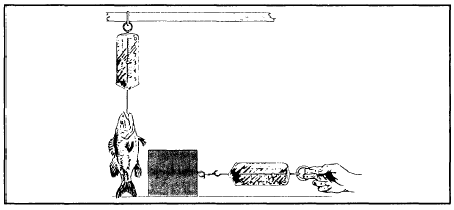
Figure 9-1.—You can measure force with a scale.
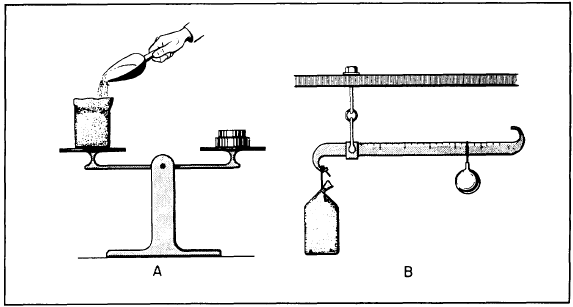
Figure 9-2.—Balances.
Unfortunately, the more springs are used, the more they lose their ability to snap back to their original position. Hence, an old spring or an overloaded spring will give inaccurate readings.
Balanced Scale
The problem with the spring-type scale eventually led to the invention of the balanced scale, shown in figure 9-2. This type of scale is an application of first-class levers. The one shown in figure 9-2, A, is the simplest type. Since the distance from the fulcrum to the center of each platform is equal, the scales balance when equal weights are placed on the platforms. With your knowledge of levers, you can figure out how the steel yard shown in figure 9-2, B, operates.
PRESSURE
Pressure is the amount of force within a specific area. You measure air, steam, and gas pressure and the fluid pressure in hydraulic systems in pounds per square inch (psi). However, you measure water pressure in pounds per square foot. You’ll find more about pressure measurements in chapter 10. To help you better understand pressure, let’s look at how pressure affects your ability to walk across snow.
Have you ever tried to walk on freshly fallen snow to have your feet break through the crust when you put your weight on it? If you had worn snowshoes, you could have walked across the snow without sinking; but do you know why? Snowshoes do not reduce your weight, or the amount of force, exerted on the snow; they merely distribute it over a larger area. In doing that, the snowshoes reduce the pressure per square inch of the force you exert.
Let’s figure out how that works. If a man weighs 160 pounds, that weight, or force, is more or less evenly distributed by the soles of his shoes. The area of the soles of an average man’s shoes is roughly 60 square inches. Each of those square inches has to carry 160 ÷ 60= 2.6 pounds of that man’s weight. Since 2 to 6 pounds per square inch is too much weight for the snow crest to support, his feet break through.
When the man puts on snowshoes, he distributes his weight over an area of about 900 square inches, depending on the size of the snowshoes. The force on each of those square inches is equal to only 160 ÷ 900 = 0.18 pounds. Therefore, with snowshoes on, he exerts a pressure of 0.18 psi. With this decreased pressure, the snow can easily support him.
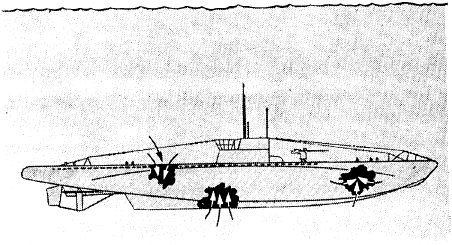
Figure 9-3.-Fluids exert pressure in all directions.
CALCULATING PRESSURE
To calculate pressure, divide the force by the area on which you apply force. Use the following formula:
![]()
or
![]()
To understand this idea, follow this problem. A fresh water holding tank aboard a ship is 10 feet long, 6 feet wide, and 4 feet deep. Therefore, it holds 10 x 6 x 4, or 240, cubic feet of water. Each cubic foot of water weighs about 62.5 pounds. The total force outside the tank’s bottom is equal to the weight of the water: 240 x 62.5, or 15,000 pounds. What is the pressure on the bottom of the tank? Since the weight is even on the bottom, you apply the formula ![]() and substitute the proper F and A. In this case, F= 15,000 pounds; the area of the bottom in square inches is 10 x 6 x 144, since 144 square inches = 1 square foot.
and substitute the proper F and A. In this case, F= 15,000 pounds; the area of the bottom in square inches is 10 x 6 x 144, since 144 square inches = 1 square foot.
![]()
Now work out the idea in reverse. You live at the bottom of the great sea of air that surrounds the earth. Because the air has weight—gravity pulls on the air too—the air exerts a force on every object that it surrounds. Near sea level that force on an area of 1 square inch is roughly 15 pounds. Thus, the air-pressure at sea level is about 15 psi. The pressure gets less and less as you go up to higher altitudes.
With your finger, mark out an area of 1 square foot on your chest. What is the total force pushing on your chest? Again use the formula ![]() . Now substitute P and 144 square inches for A. Then, F = 144 x 15, or 2,160 pounds. The force on your chest is 2,160 pounds per square foot-more than a ton pushing against an area of 1 square foot. If no air were inside your chest to push outward with the same pressure, you’d be flatter than a bride’s biscuit.
. Now substitute P and 144 square inches for A. Then, F = 144 x 15, or 2,160 pounds. The force on your chest is 2,160 pounds per square foot-more than a ton pushing against an area of 1 square foot. If no air were inside your chest to push outward with the same pressure, you’d be flatter than a bride’s biscuit.
MEASURING FLUID PRESSURE
All fluids-both liquids and gases—exert pressure. A fluid at rest exerts equal pressure in all directions. As shown in figure 9-3, water will push through a hole in a submarine, whether it is in the top, the bottom, or in one of the sides.
Many jobs aboard ship will require you to know the pressure exerted by a gas or a liquid. For example, knowing the steam pressure inside a boiler is always important. You can use three different gauges to find the pressure of fluids: Bourdon gauge, Schrader gauge, and diaphragm gauge.
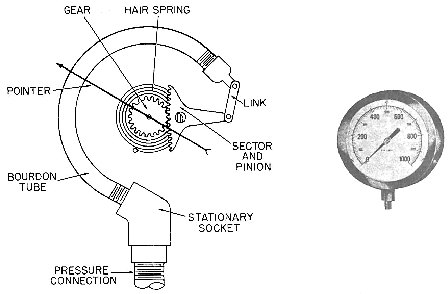
Figure 9-4.-The Bourdon gauge.
Bourdon Gauge
The Bourdon gauge is shown in figure 9-4. It works on the same principle as that of the snakelike, paper party whistle you get at a New Year party, which straightens when you blow into it.
Within the Bourdon gauge is a thin-walled metal tube, somewhat flattened and bent into the form of a C. Attached to its free end is a lever system that magnifies any motion of the free end of the tube. On the fixed end of the gauge is a fitting you thread into a boiler system. As pressure increases within the boiler, it travels through the tube. Like the snakelike paper whistle, the metal tube begins to straighten as the pressure increases inside of it. As the tube straightens, the pointer moves around a dial that indicates the pressure in psi.
The Bourdon gauge is a highly accurate but rather delicate instrument. You can easily damage it. In addition, it malfunctions if pressure varies rapidly. This problem was overcome by the development of another type of gauge, the Schrader. The Schrader gauge (fig. 9-5) is not as accurate as the Bourdon, but it is sturdy and suitable for ordinary hydraulic pressure measurements. It is especially suitable for fluctuating loads.
In the Schrader gauge, liquid pressure actuates a piston. The pressure moves up a cylinder against the resistance of a spring, carrying a bar or indicator with it over a calibrated scale. The operation of this gauge eliminates the need for cams, gears, levers, and bearings.
Diaphragm Gauge
The diaphragm gauge gives sensitive and reliable indications of small pressure differences. We use the diaphragm gauge to measure the air pressure in the space between inner and outer boiler casings.
In this type of gauge, a diaphragm connects to a pointer through a metal spring and a simple linkage system (fig. 9-6). One side of the diaphragm is exposed to the pressure being measured, while the other side is exposed to the pressure of the atmosphere. Any increase in the pressure line moves the diaphragm upward against the spring, moving the pointer to a higher reading. When the pressure decreases, the spring moves the diaphragm downward, rotating the pointer to a lower reading. Thus, the position of the pointer is balanced between the pressure pushing the diaphragm upward and the spring action pushing down. When the gauge reads 0, the pressure in the line is equal to the outside air pressure.
MEASURING AIR PRESSURE
To the average person, the chief importance of weather is reference to it as an introduction to general conversation. At sea and in the air, advance knowledge of what the weather will do is a matter of great concern
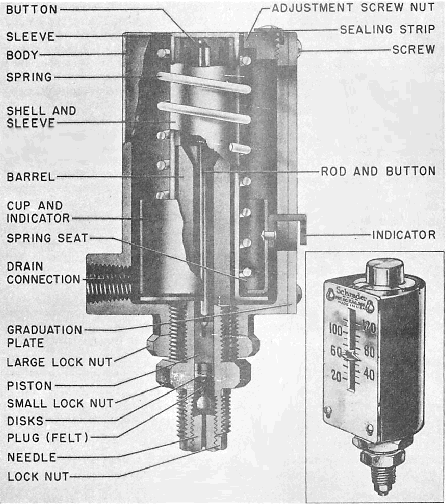
Figure 9-5.—The Schrader gauge.
to all hands. We plan or cancel operations on the basis of weather predictions. Accurate weather forecasts are made only after a great deal of information has been collected by many observers located over a wide area.
One of the instruments used in gathering weather data is the barometer, which measures air pressure. Remember, the air is pressing on you all the time. Normal atmospheric pressure is 14.7 psi. As the weather changes, the air pressure may be greater or less than normal. Air from high-pressure areas always moves toward low-pressure areas, and moving air—or wind-is one of the main causes of weather changes. In general, as air moves into a low-pressure area, it causes wind, rain, and storms. A high-pressure area usually enjoys clear weather. Ships use two types of barometers to measure air pressure: aneroid and mercurial.
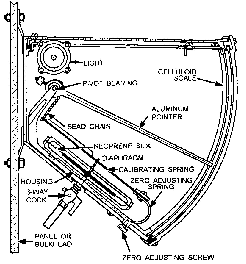
Figure 9-6.—Diaphragm pressure gauge.

Figure 9-7.-An aneroid barometer.
Since air pressure affects weather, you can see why the use of a barometer is so important to ships. However, not so apparent is the importance of air pressure in the operation of the ship’s engine. For that purpose air pressure is measured with a gauge called a manometer.
Aneroid Barometer
The aneroid barometer shown in figure 9-7 is an instrument that measures air pressure at sea level. It consists of a thin-walled metal box from which most of the air has been pumped and a dial indicating low- and high-pressure measurements. A pointer on the dial is connected to the box by a lever system. If the pressure of the atmosphere increases, it squeezes the sides of the box. This squeeze causes the pointer to move toward the high-pressure end of the dial. If the pressure decreases, the sides of the box expand outward. That causes the pointer to move toward the low-pressure end of the dial. Notice that the numbers on the dial are from 27 to 31. This scale of numbers is used because average sea level pressure is 29.92 inches and readings below 27 inches or above 31 inches are rarely seen.

Figure 9-8.-A mercurial barometer.
Mercurial Barometer
Figure 9-8 illustrates a mercurial barometer. It consists of a glass tube on which measurements are indicated; the tube is partially filled with mercury. The upper end, which is closed, contains a vacuum above the mercury. The lower end, which is open, is submerged in a cup of mercury that is open to the atmosphere. The atmosphere presses down on the mercury in the cup and pushes the mercury up in the tube. The greater the air pressure, the higher the rise of mercury within the tube. At sea level, the normal pressure is 14.7 psi, and the height of the mercury in the tube is 30 inches. As the air pressure increases or decreases from day to day, the height of the mercury rises or falls. A mercury barometer aboard ship mounts in gimbals to keep it in a vertical position despite the rolling and pitching of the ship. The dial of most gauges indicate relative pressure; that is, it is either greater or less than normal. Remember-the dial of an aneroid barometer always indicates absolute pressure, not relative. When the pressure exerted by any gas is less than 14.7 psi, you have what we call a partial vacuum.
Manometer
The condensers on steam turbines operate at a pressure well below 14.7 psi. Steam under high pressure
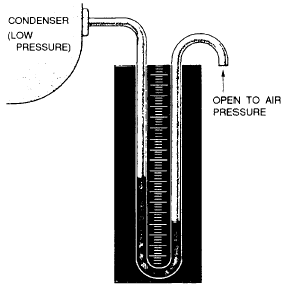
Figure 9-9.-A manometer.
runs into the turbine and causes the rotor to turn. After it has passed through the turbine, it still exerts a back pressure against the blades. If the back pressure were not reduced, it would build until it became as great as that of the incoming steam and prevent the turbine from turning at all. Therefore, the exhaust steam is run through pipes surrounded by cold sea water to reduce the back pressure as much as possible. The cold temperature causes the steam in the pipes to condense into water, and the pressure drops well below atmospheric pressure.
The engineer needs to know the pressure in the condensers at all times. To measure this reduced pressure, or partial vacuum, the engineer uses a gauge called a manometer. As shown in figure 9-9, it consists of a U-shaped tube. One end is connected to the low-pressure condenser, and the other end is open to the air. The tube is partially filled with colored water. The normal air pressure against the colored water is greater than the low pressure of the steam from the condenser. Therefore, the colored water is forced part of the way into the left arm of the tube. A scale between the two arms of the U indicates the difference in the height of the two columns of water. This difference tells the engineer the degree of vacuum-or how much below atmospheric pressure the pressure within the condenser is.
SUMMARY
You should remember seven points about force and pressure:
A force is a push or a pull exerted on or by an object. You measure force in pounds.
Pressure is the force per unit area exerted on an object or exerted by an object. You measure it in pounds per square inch (psi).
You calculate pressure by the formula ![]() .
.
Spring scales and lever balances are familiar instruments you use for measuring forces.
Bourdon gauges, barometers, and manometers are instruments for the measurement of pressure.
The normal pressure of the air is 14.7 psi at sea level.
Pressure is generally relative; that is, it is sometimes greater—sometimes less—than normal air pressure. Pressure that is less than the normal air pressure is called a vacuum.

Tidak ada komentar:
Posting Komentar